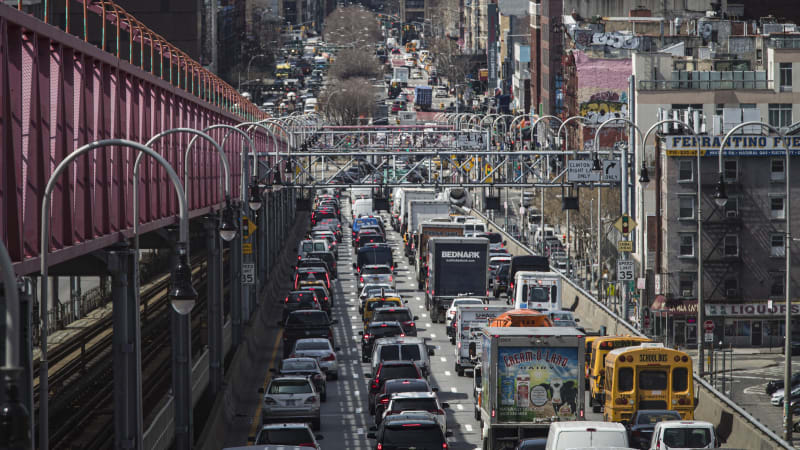NYC's $15 congestion tax wins initial approval

New York City’s plan to charge motorists driving into Manhattan’s central business district inched forward as a proposed tolling structure received an initial approval from the Metropolitan Transportation Authority.
The MTA’s governing board voted nine to one Wednesday to allow the tolling program to move forward. The agency, which operates the city’s subways, buses and commuter rail trains, is implementing the congestion pricing tolling plan. Passenger cars with an E-ZPass will pay $15 during peak periods, while trucks pay $24 to $36. It’s the first such program in the US.
The initial approval allows the MTA to begin a public comment period on the tolling structure. Officials anticipate congestion pricing will bring in $1 billion annually that the transit agency will borrow against to raise $15 billion for its $51.5 billion multi-year capital budget. That spending plan includes modernizing subway signals, extending the Second Avenue subway to 125th Street and adding escalators and elevators to make the system more accessible for everyone.
Congestion pricing gives the MTA, which already has $47 billion of outstanding debt, a new revenue source to fund necessary infrastructure needs, said Neal Zuckerman, an MTA board member who chairs its finance committee.
“We’re spending 15% of our operating budget servicing that debt,” Zuckerman said. “Congestion pricing is necessary for plugging the gap of the building, the repairing, the fixing we must do.”
The MTA is eager to get the new toll revenue flowing into its capital budget. It has already delayed a $1.3 billion project to update signals on the A and C subway lines in Brooklyn because its funding relies on congestion pricing revenue. More project delays could come. The anticipated cash from the tolls would account for up 50% of the remaining funding in the MTA’s capital plan.
“We’ve knocked out as many of the projects as we can that did not depend on congestion pricing,” Janno Lieber, the MTA’s chief executive officer, said during Wednesday’s meeting. “Now we’re coming to the point where we really start to need that money.”
The goal is for drivers to start paying the toll in May or June, but a New Jersey lawsuit may push out the implementation. Governor Phil Murphy has filed suit to get a court to force the MTA to undergo a longer environmental analysis.
The MTA can make some changes to the tolling structure. The transit agency will now analyze how to exempt public school buses from the toll after some board members raised concerns. The board also mentioned giving a break to yellow-taxi passengers, although incorporating that type of change could be challenging, Lieber told reporters after the board meeting.
“When you make tweaks to it, it definitely creates diversions, different traffic patterns, which then have to be restudied,” Lieber said. “And in a doomsday scenario, would run afoul of the limits placed by the environmental assessment.”
Related: NYC’s $15 Congestion Pricing Risks Delay From New Jersey Lawsuit
The fee would apply once a day to drivers entering Manhattan south of 60th Street from 5 a.m. to 9 p.m. on weekdays and between 9 a.m. and 9 p.m. on weekends, with tolls 75% lower during the night. There’s a 50% increase for vehicles without an E-ZPass. The proposal includes a credit for drivers entering the district through certain tunnels.
The plan includes potentially boosting the tolls by 25% during so-called gridlock alert days, which is the holiday season and also the United Nations’ General Assembly.
The toll wouldn’t apply to taxi drivers and for-hire vehicles, but instead charge passengers per ride, $1.25 for taxis and $2.50 to those in ride-shares like Uber or Lyft.
The tolling plan calls for a $5 credit to passenger vehicles entering Manhattan through four tunnels: Queens-Midtown connecting Manhattan to Long Island City, the Hugh L. Carey — a bypass to downtown from Brooklyn, and both the Holland and Lincoln which connect to New Jersey. Small trucks would get $12 while large trucks and tour buses would receive $20.
John Samuelsen, Transport Workers Union’s international president and a non-voting MTA board member, has said the MTA needs to add more express bus routes in underserved areas and more frequent local bus service to get more commuters to take public transportation instead of driving. Samuelsen was on the Traffic Mobility Review Board, which recommended the tolling structure. He resigned last week, saying the program doesn’t include sufficient service changes.
“We’re talking about targeted service increases, perhaps in the far reaches of the outer boroughs, that would encourage those who currently drive to get out of their cars and onto public transit,” Samuelsen told reporters after the board meeting.







